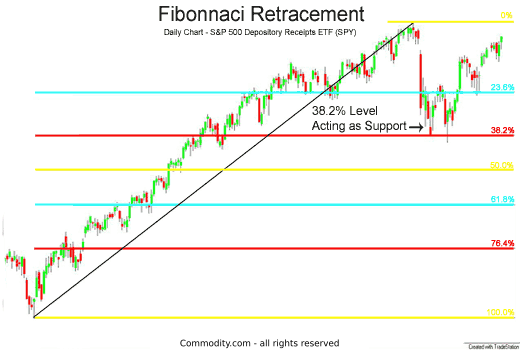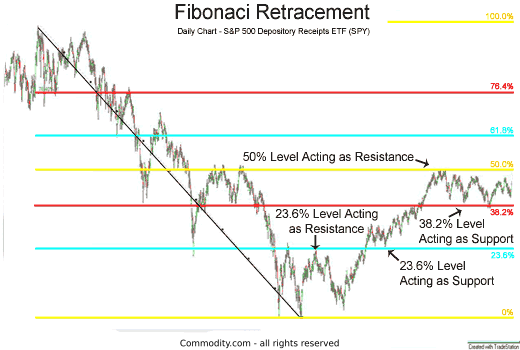Alat Fibonacci menggunakan nisbah khas yang secara semula jadi berlaku di alam untuk membantu meramalkan titik sokongan atau rintangan. Nombor Fibonacci adalah 1, 1, 2, 3, 5, 8, 13, 21, 34, 55, 89, dll. Urutan berlaku dengan menambahkan dua nombor sebelumnya (iaitu 1 + 1 = 2, 2 + 3 = 5) Nisbah utama yang digunakan ialah .618, ini dijumpai dengan membahagikan satu nombor Fibonacci menjadi nombor Fibonacci seterusnya (55/89 = 0.618). Logik yang paling sering digunakan oleh peniaga berasaskan Fibonacci adalah kerana bilangan Fibonacci berlaku di alam semula jadi dan pasaran saham, niaga hadapan, dan mata wang adalah ciptaan alam – manusia. Oleh itu, urutan Fibonacci harus berlaku untuk pasaran kewangan. Terdapat banyak alat Fibonacci yang digunakan oleh peniaga, termasuk:
Fibonacci tools utilize special ratios that naturally occur in nature to help predict points of support or resistance. Fibonacci numbers are 1, 1, 2, 3, 5, 8, 13, 21, 34, 55, 89, etc. The sequence occurs by adding the previous two numbers (i.e. 1+1=2, 2+3=5) The main ratio used is .618, this is found by dividing one Fibonacci number into the next in sequence Fibonacci number (55/89=0.618). The logic most often used by Fibonacci based traders is that since Fibonacci numbers occur in nature and the stock, futures, and currency markets are creations of nature – humans. Therefore, the Fibonacci sequence should apply to the financial markets. There are many Fibonacci tools used by traders, they include:
- Fibonacci Retracements
- Fibonacci Arcs
- Fibonacci Fans
- Fibonacci Time Extensions

Fibonacci Retracements Boleh dikatakan alat Fibonacci yang paling banyak digunakan adalah Fibonacci Retracement. Untuk mengira tahap Fibonacci Retracement, mesti didapati rendah yang signifikan hingga tinggi yang tinggi. Dari sana, harga harus menelusuri perbezaan awal (rendah ke tinggi atau tinggi ke rendah) dengan nisbah urutan Fibonacci, umumnya 23.6%, 38.2%, 50%, 61.8%, atau retracement 76.4%.
Fibonacci Retracements Arguably the most heavily used Fibonacci tool is the Fibonacci Retracement. To calculate the Fibonacci Retracement levels, a significant low to a significant high should be found. From there, prices should retrace the initial difference (low to high or high to low) by a ratio of the Fibonacci sequence, generally the 23.6%, 38.2%, 50%, 61.8%, or the 76.4% retracement.
Untuk contoh bahagian ini, Resit Depositori S&P 500 (SPY) akan digunakan berdasarkan logik bahawa S&P 500 adalah ukuran sifat manusia yang luas, oleh itu urutan Fibonacci harus berlaku dengan baik. Walaupun begitu, urutan Fibonacci diterapkan pada saham, komoditi, dan pasangan mata wang forex secara berkala. Carta di atas menunjukkan retracement 38.2% bertindak sebagai sokongan untuk harga.
For the examples of this section, the S&P 500 Depository Receipts (SPY) will be used based on the logic that the S&P 500 is a broad measure of human nature, thus the Fibonacci sequence should apply very well. Nevertheless, the Fibonacci sequence is applied to individual stocks, commodities, and forex currency pairs quite regularly. The chart above shows the 38.2% retracement acting as support for prices.
Perhatikan bahawa garis arah aliran diambil dari tahap rendah (permulaan tren) ke tahap tinggi yang tinggi (akhir aliran); perisian perdagangan mengira tahap penurunan.
Note that a trendline was drawn from a significant low (beginning of trend) to a significant high (end of trend); the trading software calculated the retracement levels.
Carta di bawah SPY menunjukkan bahawa Fibonacci Retracements boleh digunakan untuk menelusuri kembali aliran menurun:
The chart below of the SPY’s shows that Fibonacci Retracements can be used to retrace downtrend moves as well:

Perhatikan selepas bahagian bawah dalam S&P 500, harga itu naik ke tahap retracement 23.6% dan kemudian segera ditolak ke bawah. Setelah memecahkan rintangan beberapa bulan kemudian, retracement 23.6% menjadi sokongan (lihat: Sokongan & Rintangan). Harga naik sehingga tahap retracement 50%, di mana ia naik berbanding rintangan. Harga terus berubah-ubah antara tahap retracement 38.2% (bertindak sebagai sokongan) dan tahap retracement 50% (bertindak sebagai perlawanan).
Notice after the bottom in the S&P 500, that price rallied to the 23.6% retracement level and then was promptly rejected downwards. After breaking resistance a few months later, the 23.6% retracement became support (see: Support & Resistance). Price rallied up to the 50% retracement level, where it ran up against resistance. Price continued to fluctuate between the 38.2% retracement level (acting as support) and the 50% retracement level (acting as resistance).
There are many other Fibonacci tools available to stock, forex, or futures traders. Fibonacci Arcs are discussed next.
Read more at: https://commodity.com/technical-analysis/fibonacci-retracements/